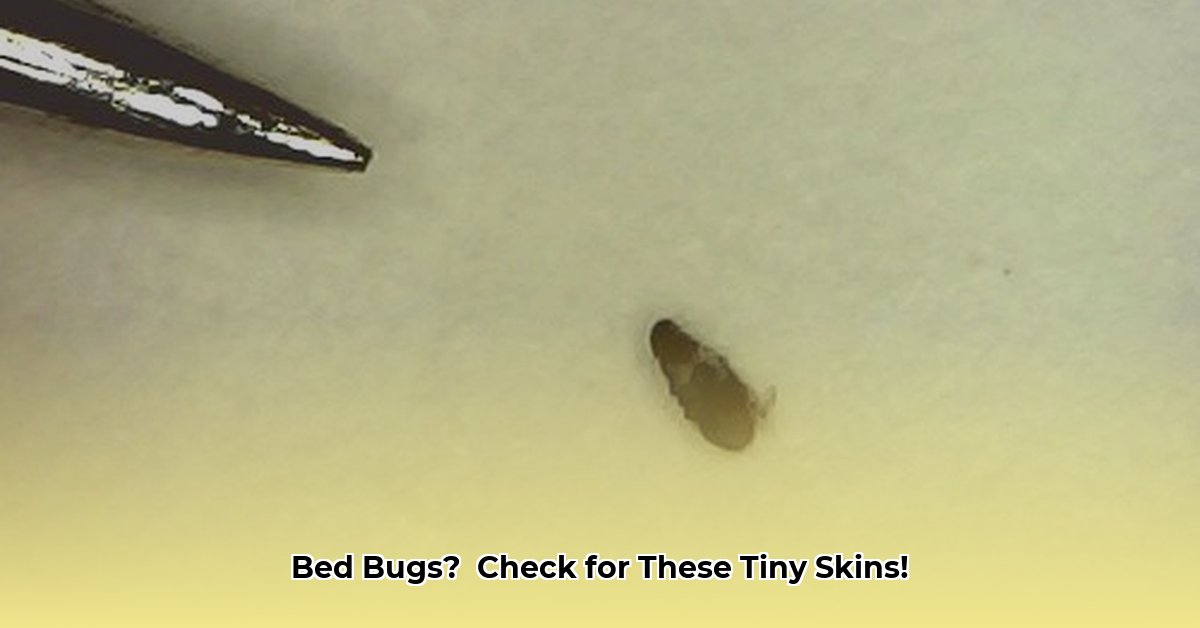Finding translucent shells around your bed can be alarming. This guide provides clear, actionable advice on bed bug cast skins, addressing your concerns and guiding you through the next steps.
What Are Bed Bug Cast Skins?
Bed bugs shed their outer skin as they grow, much like a snake shedding its skin. These discarded exoskeletons are called cast skins, or exuviae, and are a key indicator of a possible infestation. Discovering them can be unsettling, but understanding what they are is the first step to addressing the issue.
Recognizing Cast Skins
Bed bug cast skins resemble translucent, hollow versions of the actual bugs. They’re typically pale yellowish-brown and vary in size from tiny specks (early nymph stages) to about 1/5 of an inch (adult stage). Their appearance can be described as a slightly crumpled, empty shell, often retaining the basic shape of the bed bug, even with missing legs. To accurately identify cast skins, comparing them to high-quality images online is highly recommended.
Here’s a quick comparison:
| Feature | Cast Skin | Live Bed Bug |
|---|---|---|
| Appearance | Empty, translucent exoskeleton; lighter in color | Solid body; darker in color (brown to reddish-brown) |
| Movement | Immobile | Mobile; often scurries when disturbed |
| Shape | Resembles a flattened, oval shape | Flat, oval-shaped; becomes more rounded after feeding |
Common Hiding Spots
Bed bugs and their cast skins prefer dark, undisturbed areas near their food source. Common hiding places include:
- Mattress and Box Spring: Check seams, crevices, and the underside.
- Bed Frame and Headboard: Inspect cracks, joints, and hidden spaces.
- Nearby Furniture: Examine upholstered furniture seams and crevices.
- Wall Cracks and Baseboards: Look for these tiny shells in tight spaces.
- Electrical Outlets: Surprisingly, bed bugs can hide inside these as well.
Finding multiple skins clustered together suggests a more established presence.
Do Cast Skins Confirm an Infestation?
Finding cast skins strongly suggests bed bugs were or are present. It’s similar to finding a snakeskin—it confirms a snake was there, but not necessarily that it still is. The quantity of skins might suggest the infestation’s size, but it isn’t a definitive measure. Even a few skins warrant investigation. Some experts believe that cast skins, along with other signs, are crucial for early detection and treatment.
What to Do if You Find Cast Skins
- Inspect Thoroughly: Systematically examine your bedroom and surrounding areas. Look for live bed bugs (small, flat, reddish-brown), dark fecal stains (tiny ink dots), and tiny white eggs.
- Contain the Area (If Possible): If you find evidence on specific items, isolate them. Encase your mattress and box spring in zippered bed bug covers. Bag potentially infested clothing and other items to prevent further spread.
- Contact a Pest Control Professional: This is the most effective approach. Professionals have the expertise and tools for accurate assessment and treatment. Early intervention prevents a small problem from escalating.
Treatment options may include:
- DIY methods: Vacuuming (dispose of the bag immediately), steam cleaning (at least 140°F for several minutes), and laundering items in hot water (at least 120°F) and drying on high heat. While these methods can kill some bed bugs, they are unlikely to eliminate a full infestation.
- Professional pest control: The most reliable method, especially for significant infestations. Professionals assess the situation, develop a treatment plan, and provide follow-up to ensure complete eradication.
Managing Anxiety
Finding bed bugs can be incredibly stressful, but it’s important to remember that:
- It’s not your fault: Bed bugs are opportunistic and can infest any home, regardless of cleanliness.
- You’re not alone: Many people experience bed bug infestations.
- There are solutions: Focus on taking action and remember professional help is available.
If you find yourself struggling, talking to a friend, family member, or mental health professional can help.
Frequently Asked Questions
Are bed bug cast skins dangerous?
No, the cast skins themselves are harmless. They don’t bite or transmit diseases. The concern lies with the potential presence of live bed bugs.
Additional Information
For more comprehensive information on bed bugs, their life cycle, and treatment options, consult reputable sources like the EPA: https://www.epa.gov/bedbugs
- How Did Charles F. Brush Discover Wind Energy Tech? - November 19, 2025
- Wind Energy Vertical: Weighing the Pros and Cons of Wind Power - November 16, 2025
- How Much Energy Does a Wind Turbine Actually Create? - November 14, 2025
















